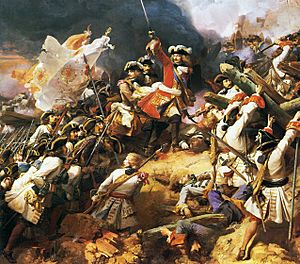Claude Louis Hector de Villars facts for kids
Quick facts for kids
Marshal General
Claude Louis Hector de Villars
|
|
|---|---|

Portrait by Hyacinthe Rigaud
|
|
| Secretary of State for War | |
| In office 1 October 1715 – 24 September 1718 |
|
| Monarch | Louis XV |
| Preceded by | Daniel Voysin de la Noiraye |
| Succeeded by | Claude le Blanc |
| Personal details | |
| Born | 8 May 1653 Moulins, Kingdom of France |
| Died | 17 June 1734 (aged 81) Turin, Kingdom of Sardinia |
| Signature | |
| Military service | |
| Allegiance | |
| Branch/service | French Army |
| Years of service | 1671-1734 |
| Rank | Marshal General |
| Battles/wars | Franco-Dutch War
Nine Years' War
|
Claude Louis Hector de Villars (born May 8, 1653 – died June 17, 1734) was a famous French military leader. He was a very important general for King Louis XIV. Villars was one of only six people in French history to become a Marshal General of France, which was a very high military rank. He also held the titles of Prince de Martigues and Duc de Villars.
Contents
Early Military Career
Villars was born in Moulins, France. His family was noble but not rich. His father, Pierre de Villars, was a diplomat. Claude Louis Hector de Villars joined the French army in 1671.
He quickly showed his bravery and skill. At age 20, he fought well in the Siege of Maastricht in 1673. This was during the Franco-Dutch War. A year later, after the fierce Battle of Seneffe, he was promoted to colonel. This was a battlefield promotion, which was a great honor.
Even though he served under famous generals like Turenne and The Great Condé, his next promotion took some time. This was because a powerful official, Louvois, did not like him. Finally, in 1687, he became a maréchal de camp, another high rank.
Between wars, Villars also worked as a diplomat. He was sent on a special mission to Bavaria. There, he became good friends with Maximilian II Emanuel, Elector of Bavaria. In 1690, he returned to France. He was given command of cavalry in Flanders. Later, in 1698, he became an ambassador to Vienna.
War of the Spanish Succession

Villars became most famous during the War of the Spanish Succession. This war started in 1702 and ended in 1712. His first notable battles were Friedlingen (1702) and Hochstadt (1703). For his actions at Friedlingen, he was made a Marshal of France. He also helped bring peace to the Cévennes region, where people were rebelling. For this, he received a special award and the title of duke.
The battles of Friedlingen and Hochstadt were not huge victories. But Villars's greatest achievements came later. In 1709, France was in a very difficult situation. The enemy forces were making tough demands. Villars was chosen to lead the main French army. This army faced the combined forces of Prince Eugène of Savoy and Marlborough.
During a harsh winter, Villars shared the same poor food as his soldiers. This showed his dedication. When the fighting began, the old Marshal Boufflers even volunteered to serve under him. After the terrible Battle of Malplaquet, Villars was badly wounded in the knee. Despite this, he famously told the king: "If it please God to give your majesty's enemies another such victory, they are ruined." This meant that even though France lost, the enemy suffered so much that another such victory would destroy them.
Two more years passed without a major battle. The invaders made little progress. Then, Marlborough managed to get past Villars's strong defensive lines. It seemed France's defense was broken. But King Louis XIV made one last effort. The English army and its leader, Marlborough, left the enemy's side. Villars, still recovering from his Malplaquet wounds, used his skill to outsmart Prince Eugène. He decisively defeated him at the Battle of Denain.
This victory at Denain saved France from defeat. The war continued for another year. Villars led the Rhine campaign (1713). He captured the city of Landau and led the attack on Freiburg. He then helped negotiate the peace treaties, the Treaty of Rastatt and the Treaty of Baden, with Prince Eugène. Because of his great contributions, King Philip V of Spain gave him the special status of Grandee of Spain.
Villars' Residence
The Villars building in Moulins, Allier was named after Marshal Villars. It was built during the time of King Louis XV. This 18th-century building was once used as a barracks for cavalry soldiers. It was partly damaged during World War II. Later, it was restored and is now the Centre National du Costume de Scene museum.
Later Life and Legacy
Villars was also active in politics during the Regency period. He was a main opponent of Cardinal Dubois. He almost became constable of France, a very high military and political position.
He fought for the last time in the War of the Polish Succession in 1734. He was given the title marshal-general of the king's armies, a title previously held by Turenne. At this point, he was over eighty years old. He started the campaign with energy but sadly died in Turin on June 17, 1734.
Villars's memoirs, which are his written memories, show him as a brave and honorable person. He was known for being boastful and wanting honors and wealth. However, he was also described as a very skilled and courageous soldier. His memoirs were first published in 1734. Later, they were fully edited by the Marquis de Vogüé between 1884 and 1892.
See also
 In Spanish: Claude Louis Hector de Villars para niños
In Spanish: Claude Louis Hector de Villars para niños
Images for kids





